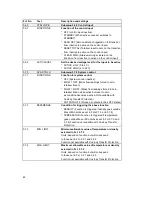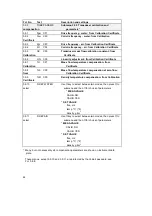
51
Under certain circumstances, when the media consists of unevenly mixed components, it
might be difficult to adjust the zero point. In such a case, the zero point adjustment procedure
must be carried out under special conditions :
–
Media which tend to vaporise or degas should be kept under higher pressure.
–
Two-phase media consisting of a separable solid component (slurry): In such a case it
might be advisable to fill the primary head with the carrier medium only.
–
Other two-phase media .
If it is not possible to separate the solid or gaseous components, the operator can fill the
measuring system with a substitute liquid (e.g. with water).
6.2
Low Flow Cutoff (Fct. 1.1.2 and 3.1.2)
If the FLOW MODE (Fct. 3.1.8) is set to FLOW +/- then at zero flow small signal fluctuations
will average out to nothing and the totaliser will remain fixed. However, if "one-way flow" is
selected, this averaging process will not work and the totaliser reading will increase slowly with
time. To prevent this the Low Flow Cutoff should be set.
The Low Flow Cutoff is entered as a percentage of the rated flow of the primary head. The
cutoff may be set in the range of 0.0 to 10.0% in steps of 0.1%.
Thus, for a 10E instrument with a low flow cutoff of 0.2%, any flows less than 0.02 kg/min are
taken as 0 kg/min.
To set the Low Flow Cutoff to 1% :
6.3
Time constant
Measurements taken from the primary head require filtering in order to give stable readings in
the presence of fluctuating flows. The degree of filtering also affects how quickly the reading
responds to rapid changes in flow.
SHORT TIME CONSTANT:
FAST RESPONSE
FLUCTUATING READING
LONG TIME CONSTANT:
SLOW RESPONSE
STABLE READING
Figure 33 shows the typical response of the system for varying Time Constants and a sharp
change in flow.
Key.
Display
line 1
line 2
→→→
Fct. 1.1.(1)
ZERO SET
↑
Fct. 1.1.(2)
L.F.CUTOFF
→
(0)0.0
PERCENT
→↑
(1).0
PERCENT
↵
Fct. 1.1.2
L.F. CUTOFF
4x
↵
















































